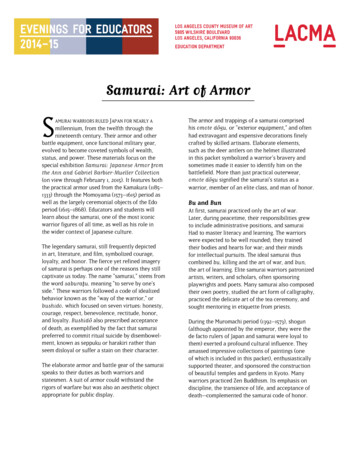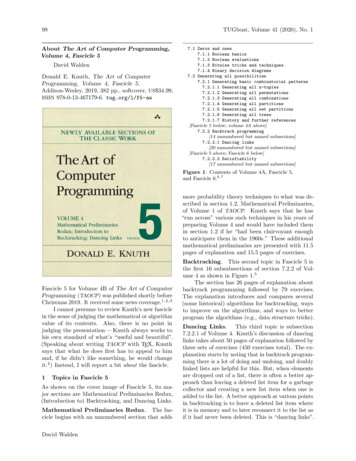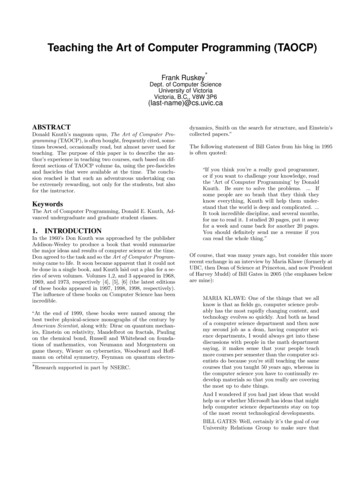
Transcription
Samurai: Art of ArmorSAMURAI WARRIORS RULED JAPAN FOR NEARLY Amillennium, from the twelfth through thenineteenth century. Their armor and otherbattle equipment, once functional military gear,evolved to become coveted symbols of wealth,status, and power. These materials focus on thespecial exhibition Samurai: Japanese Armor fromthe Ann and Gabriel Barbier-Mueller Collection(on view through February 1, 2015). It features boththe practical armor used from the Kamakura (1185–1333) through the Momoyama (1573–1615) period aswell as the largely ceremonial objects of the Edoperiod (1615–1868). Educators and students willlearn about the samurai, one of the most iconicwarrior figures of all time, as well as his role inthe wider context of Japanese culture.The legendary samurai, still frequently depictedin art, literature, and film, symbolized courage,loyalty, and honor. The fierce yet refined imageryof samurai is perhaps one of the reasons they stillcaptivate us today. The name “samurai,” stems fromthe word saburafu, meaning “to serve by one’sside.” These warriors followed a code of idealizedbehavior known as the “way of the warrior,” orbushido, which focused on seven virtues: honesty,courage, respect, benevolence, rectitude, honor,and loyalty. Bushidō also prescribed acceptanceof death, as exemplified by the fact that samuraipreferred to commit ritual suicide by disembowelment, known as seppuku or harakiri rather thanseem disloyal or suffer a stain on their character.The elaborate armor and battle gear of the samuraispeaks to their duties as both warriors andstatesmen. A suit of armor could withstand therigors of warfare but was also an aesthetic objectappropriate for public display.The armor and trappings of a samurai comprisedhis omote dōgu, or “exterior equipment,” and oftenhad extravagant and expensive decorations finelycrafted by skilled artisans. Elaborate elements,such as the deer antlers on the helmet illustratedin this packet symbolized a warrior’s bravery andsometimes made it easier to identify him on thebattlefield. More than just practical outerwear,omote dōgu signified the samurai’s status as awarrior, member of an elite class, and man of honor.Bu and BunAt first, samurai practiced only the art of war.Later, during peacetime, their responsibilities grewto include administrative positions, and samuraiHad to master literacy and learning. The warriorswere expected to be well rounded; they trainedtheir bodies and hearts for war; and their mindsfor intellectual pursuits. The ideal samurai thuscombined bu, killing and the art of war, and bun,the art of learning. Elite samurai warriors patronizedartists, writers, and scholars, often sponsoringplaywrights and poets. Many samurai also composedtheir own poetry, studied the art form of calligraphy,practiced the delicate art of the tea ceremony, andsought mentoring in etiquette from priests.During the Muromachi period (1392–1573), shogun(although appointed by the emperor, they were thede facto rulers of Japan and samurai were loyal tothem) exerted a profound cultural influence. Theyamassed impressive collections of paintings (oneof which is included in this packet), enthusiasticallysupported theater, and sponsored the constructionof beautiful temples and gardens in Kyoto. Manywarriors practiced Zen Buddhism. Its emphasis ondiscipline, the transience of life, and acceptance ofdeath—complemented the samurai code of honor.
Historic Rise . . . and FallSamurai, part of the elite members of society,represented only eight percent of the population.The rise of this warrior class in Japanese cultureinitially resulted from the inward focus of theemperor and his imperial court, neglecting manyadministrative duties. Gradually, Japan becamefragmented into small, feudal domains controlled byprovincial lords or daimyo. They system was similarto European feudalism, with castle lords and theirvassals. The daimyo in turn cultivated samurai tohelp protect and maintain his lands. The increasinglynumber of samurai created a surge in demand forarms and armor as several craftsmen were neededto make the many different elements required tooutfit men and horses. The imperial court wouldbecome largely ceremonial, and by the end of thetwelfth century, Japan was governed by a militarygovernment led by the shogun, or chief military ruler.Eventually, the dress, cultural values, and traditionsof the samurai came to dominate Japan.In 1853, American Commodore Matthew C. Perrylanded on the shores of Japan. He demanded tradingrights and forced the weak government to sign atreaty with the United States. This opened Japan tothe US and the world. The Tokugawa shogunate wasoverthrown during what became known as the MeijiRestoration. In 1876, samurai were forbidden by lawto wear swords, something that had previously beenrequired and visually designated samurai as part ofthe elite class. The samurai class was officiallydissolved during the Meiji period (1868–1912), butthe samurai’s experience in government andadministration allowed them to make vitalcontributions to the emergence of a new, modernJapan.Four images of samurai armor and accoutrementsare provided here.In 1543, a group of Portuguese sailors, whose shiphad been blown off course, landed on the coast ofJapan. With them, they brought the matchlock gun,and Japanese warfare and samurai armor wereforever changed. Suddenly, traditional armor wasineffective. In response to these new weapons ofwar, small leather and iron plates gave way tolarger, full-frontal iron sheets similar to the armorworn by European knights.The Edo period (1615–1868) was a time of relativepeace accomplished by the Tokugawa shogunatethat would prove lasting. Samurai remained readyfor combat and kept their privileged status, but theyserved more as bureaucrats and civil leaders thanactive warriors. Armor became a leading symbol ofpageantry and prestige. Samurai would dressthemselves and their horses in full armor and carryweapons for parades and the mandatory biannualprocessions between their home domains and thecapital, Edo (present-day Tokyo). Since the size andsplendor of the convoys reflected a daimyo’s status,significant resources were invested in creatingpieces of great artistic refinement meant to impress,as seen in the included images of samurai cavalry.CreditsThese curriculum materials were prepared by VeronicaAlvarez and Holly Gillette, and designed by Jenifer Shell. 2014 Museum Associates/LACMA. All rights reserved.Evenings for Educators is made possible by The Rose HillsFoundation, the Joseph Drown Foundation, and the KennethT. and Eileen L. Norris Foundation.Education programs at the Los Angeles County Museum ofArt are supported in part by the William Randolph HearstEndowment Fund for Arts Education and the Margaret A.Cargill Arts Education Endowment.
EBoshi-Shaped Helmet (Eboshi Kambuto)and Half Mask (Menpō),Japan, late 16th–17th centuryHELMETS WERE A VERY IMPORTANT PART OF Asamurai’s armor. Styles changed over timebut most were shaped in a simple dome andconstructed of anywhere from three to one hundrediron plates. Some helmets had an opening on thetop for ventilation and to allow the warrior to sliphis topknot through.Samurai often decorated their helmets with distinctive,fearsome embellishments. Such decoration becamemore important after the introduction of firearms toJapan in the sixteenth century. When guns were used,the battlefields became full of smoke and troops haddifficulty seeing. In order to be easily recognizable inbattle, warriors began wearing elaborate ornaments,such as the deer antlers seen here. This iron helmet,lacquered in gold, imitates a tall hat, or eboshi, wornat the imperial court. A youth of the samuraiclass received his first eboshi at the time of hiscoming-of-age ceremony, when he was twelveyears old. Two crescent-shaped, stylizedeyebrows (uchimayu) decorate the wide visor.The mask, made of metal, provided protectionfor the samurai’s face and throat. This half-maskcovered the lower part of the face and ischaracterized by rounded cheekbones, a smallnose, and a bushy mustache made of horsehair.Discussion Prompts What qualities do you associate with deer? The deer antlers would have made the samuraireadily visible to friend and foe alike. How doesthis exemplify the ideals of honor, duty, andcourage associated with samurai? What does this helmet tell us about the samuraiwarrior who owned it? What can we tell aboutJapanese culture from it? Think about the different types of headgearpeople wear on different occasions—such as toplay sports or to go outside when it’s very cold orhot. How is it decorated? What symbols and/orembellishments are used? What does it say aboutthe person wearing it?
EBoshi-Shaped Helmet (Eboshi Kambuto) and Half Mask (Menpõ)Japan, late 16th–17th centuryIron, gold lacquer, bronze, horn, and horsehairAnn and Gabriel Barbier-Mueller CollectionPhotograph by Brad Flowers The Ann & Gabriel Barbier-Mueller Museum, Dallas
Byōbu (folding screen),Japan, early 18th centuryTHIS SIX-PANEL FOLDING SCREEN SHOWS A FAMOUS scenefrom the warrior tale “The Heike Monogatari.” Thestory chronicles the Genpei War (1180–1185), foughtbetween two samurai clans, the Taira (also known as theHeike clan) and the Minamoto (also known as the Genjiclan) for control of Japan. Here, two Minamoto warriors,Takatsuna and Kagesue, make a friendly wager with eachother to see who can cross the rushing Uji River first.Here, Takatsuna charges ahead on his magnificent horseIkezuki, renowned for his ability to swim, and arrives atthe far side ahead of Kagesue. Their leader, Minamotocommander Yoshitsune, looks on from the right side ofthe scene. While most literature described the famoushorse Ikezuki as white, the artist depicted him as brown,blending in with the undulating waves of the river. TheGenpei War would result in the defeat of the Taira clanand the establishment of the Kamakura military ruleunder Minamoto Yoritomo in 1192.Folding screens are lightweight and portable and wereused as room dividers or as a backdrop during specialoccasions. The gold background would have helped toilluminate the dark interiors of a Japanese castle.Discussion PromptsRead the following passage from “The Heike Monogatari”:As the chilly dawn broke, the river mist hung heavyover the water, so that one could not clearly discernthe color either of the horses or the armor of theirriders. Then the commander Yoshitsune rode up tothe bank of the river, and wishing to try the courageof his men, with a glance at the foaming torrent,called out: “Shall we turn off to Yodo or Imoarai, orshall we go round by Kawachiji? Or what do you thinkof waiting until the flood abates?"Then Hatakeyama Shoji Shigetada of the province ofMusashi, who was then but twenty-one years old, stoodforth and said: "This river is one that we have oftenspoken of at Kamakura, and is no unknown stream tobaffle us; and moreover, as it flows out directly from thelake of Omi, its waters will not quickly subside, howeverlong you may wait, and as for building a bridge, who isthere who can do such a thing? In the battle that wasfought here in the era of Jisho, Ashikaga MatataroTadatsuna crossed over, and he was but a youth ofseventeen years, so here is no matter for god or devil.I, Shigetada, will be the first in the flood."And as he and his band of five hundred followerswere pushing together into the waves, two warriorswere seen to gallop forth from the point of Tachibanano-kojima at the northeast of the Byodo-in: they wereKajiwara Genda Kagesue and Sasaki Shiro Takatsuna.Each had made up his mind to be the first across,though no sign of their determination was visibleto the onlookers: Kajiwara was about three yardsin front of Sasaki. “Kajiwara, your saddle girth seemsto be loose; this is the greatest river in the westernprovinces, so you had better tighten it up." Thuswarned, Kajiwara dropped the reins onto his horse'smane, kicked his feet from the stirrups, and, leaningforward in the saddle, loosened the girth andtightened it afresh.While he was thus engaged, however, Sasakirode on past him and leapt his horse into the river.Kajiwara, thinking he had been tricked, immediatelysprang in after him. “Ho, Sasaki, “shouted Kajiwara,"Take care if you want to be famous; there is a greathawser at the bottom of the river. Look out. “At thisSasaki drew his sword and cut through the rope as itcaught his horse's feet, and in spite of the strength ofthe current, as he was mounted on the finest horse inthe land, he rode straight through the river and leaptup on to the farther bank.Kajiwara's horse Surusumi, however, was sweptaside by the rush of the water, and his rider reachedland some distance farther downstream. Then Sasaki,rising high in his stirrups, shouted with a loud voice:“Sasaki Shiro Takatsuna, fourth son of Sasaki SaburoYoshihide of Omi, descended in the ninth generationfrom Uda Tenno, is the first over the Uji River."Translation by A. L. SadlerCompare and contrast the written description of thestory with the scene on the screen. What is the mostsignificant difference between the image and the text?Think of some reasons for this difference.
TSix-panel Folding Screen (byōbu)The Competition to Be First at Uji RiverMid-Edo period, Early 18th centuryInk, color, and gold on paperThe Ann and Gabriel Barbier-Mueller CollectionPhotograph by Brad Flowers Ann & Gabriel Barbier-Mueller Museum, Dallas
Horse Armor (bagai), Horse Mask bamen), Horse Tack (bagu)(Momoyama to Edo period, 2nd half of 19th centuryTachidō tō sei gusoku armor, late Edo period, 1842IT IS BELIEVED THAT HORSES WORE ARMOR INTO BATTLE BYthe early seventeenth century. Horses played a keyrole in military strategy and were a vital means oftravel. Later, when battles involved thousands of men,many warriors fought on foot, with samurai onhorseback leading the way.Horses were also important during the peaceful Edoperiod (1615–1868). They conveyed prestige andpower for
warrior figures of all time, as well as his role in the wider context of Japanese culture. The legendary samurai, still frequently depicted in art, literature, and film, symbolized courage, loyalty, and honor. The fierce yet refined imagery of samurai is perhaps one of the reasons they still captivate us today. The name “samurai,” stems from the word saburafu, meaning “to serve by one .











